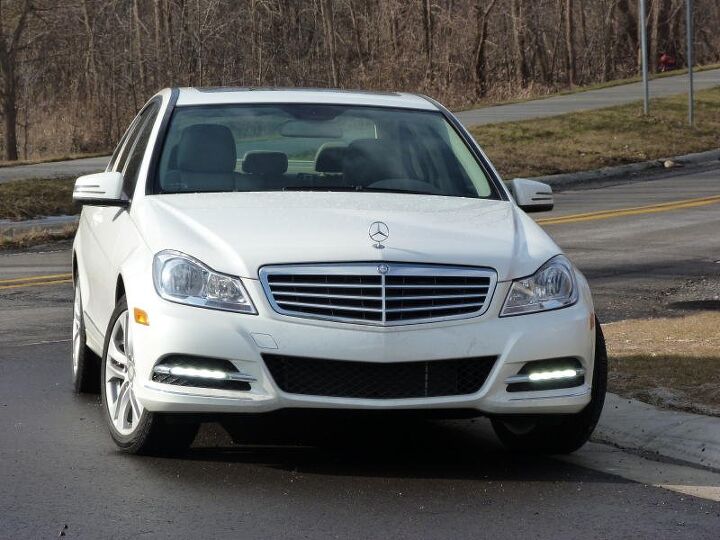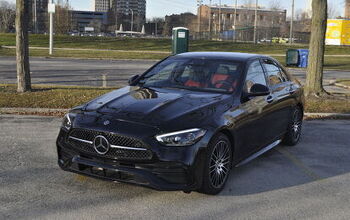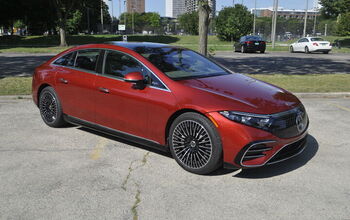Review: 2012 Mercedes-Benz C300 4Matic
People form lasting impressions at an early age. This might explain why, among the general population over 35, neither Audi nor BMW can match the mystique of a Mercedes. Even the bottom-of-the-US-range C300 raises eyebrows from people who’ll give an Audi A7 nary a passing glance (and who’d view spending an extra $8,000 for a hatchback as lunacy). But will this continue to be the case with subsequent generations, or will Mercedes follow in the footsteps of Cadillac? A brand is only as strong as its weakest link. Does the C300 justify the cachet attached to its three-pointed star?
The previous C-Class, the W203, was a prettier car. But it was also a plainer one. The W204, with its squarer cut, crisper creases, and more complicated graphics, has considerably more road presence and, of at least equal importance, looks more expensive. Most important of all: it’s widely recognizable as a Mercedes-Benz. Proof, in case you need it, that Mercedes retains latitude to break with current convention: a standing hood ornament. A Cadillac that attempted the same would be dismissed as hopelessly out-of-touch.
The interior similarly won’t win any beauty contests but through the sophistication and sheer quantity of details sufficiently suggests you’re not in a mainstream car. Materials were upgraded with this year’s refresh, and generally avoid any charges of seeming cheap (though the HVAC dials could feel more solid). Leather seating is increasingly rare on Mercedes-Benz lots, and you won’t find it inside this $43,980 specimen. But people are prone to assumptions, and the MB-Tex vinyl is hard to distinguish from the standard grade, heavily processed leather. How many people have owned a Mercedes without ever realizing that their upholstery was petroleum-based?
In an attempt to minimize the number of buttons by pairing a console-mounted knob with a multifunctional display, BMW has iDrive, Audi has MMI, and Mercedes has COMAND. That latter is neither as sophisticated nor as easy to use as the latest iterations of the others, but as with all such systems, you’ll eventually sort it out. Or not. More of a bother: Mercedes doggedly continues to position the cruise control lever where other manufacturers position the turn signal (the stalk is mounted just little lower.) Even towards the end of my week in the car I unintentionally activated the system multiple times per day. Also in need of tweaking: power seat adjustments that react too quickly for frustration-free fine-tuning.
A more positive sign that you’re in a Mercedes: the doors latch closed with a solid mechanical thunk. Though considerable engineering hours were expended refining this sound, the car comes by it honestly. The C300’s body structure oozes rock-hard solidity. Crash tests back up this impression. In a 35 mph frontal offset crash test, the structure deforms by only one to three centimeters. The side impact structural deformation figures are even more impressive. (Note: Lower numbers are better in these stats.) Mercedes are arguably unworthy of their reputation in some ways, but safety isn’t one of them.
The driving position in the C300 could hardly be better, with a more open view forward than you’ll find from behind the BMW 3-Series’s more imposing instrument panel. (My suspicion: Cadillac studied the C-Class very closely when designing the architecture for the new Cadillac ATS.) Opinions vary about Mercedes-Benz’s traditional sehr flach, sehr fest Sitze. Some people will find them properly supportive for hours. Others will simply find them flat and hard. Count me among the latter group, perhaps because I took no long trips in the car. Thankfully the seatback curves more than the bottom cushion, and so provides decent lateral support. Typical of the segment, the rear seat will accommodate adults in a pinch. A little more toe room under the front seats would go a long way. For long distance room and comfort you’ll want to step up to the E-Class or even the S-Class.
The C300 4Matic’s specs aren’t promising. While the V6s in mainstream midsize sedans start at 3.5 liters, that in the Mercedes is a mere 3.0. The mill’s 228 horsepower (at 6,000 rpm) and 221 pound feet of torque (from 2,750 to 5,000) must contend with 3,737 pounds of curb weight. And yet, through whatever magic that made the 1990s S300 viable, acceleration feels more than adequate even right off the line, and spirited with a heavy foot north of 4,000 rpm. The seven-speed automatic isn’t the quickest or slickest, but the right ratio is always in there somewhere. Two modes are provided, E and S. I could detect no difference between them. Though much has changed over the decades, the engine note retains traces of Mercedes’ traditional mechanical thrum—it doesn’t sound like any old six.
All-wheel drive is exclusively available on the C300 and no rear-drive option exists. The rear-wheel-drive C-Class is offered with either a 201-horsepower, 229-pound-feet turbocharged 1.8-liter four-cylinder or a 302-horsepower 3.5-liter V6. Though the latter is no doubt a strong performer, few dealers stock it. If even the 3.5 isn’t strong enough for you, there’s also the AMG C63 with a 451-horsepower V8.
The argument against the six: fuel economy. A larger, heavier, and more powerful BMW 528i xDrive manages EPA ratings of 22 city, 32 highway. The next 3-Series xDrive should do even better. An Audi A4 quattro: 21/29. And the 333-horsepower Audi S4: 18/28. The C300 4Matic: only 18 city, 25 highway. The trip computer backed up these subpar numbers, reporting about 20 in suburban driving. The C300’s six might punch above its specs, but this comes at a price.
The C300 is available in both Sport and Luxury trims. I’ve steered people towards the former over the years, as it adds a body kit and more athletic suspension tuning at a very un-German price: free. Scratch that: this year the better looking, better handling C-Class variant actually costs a little less. For their own reasons (that I cannot fathom) Mercedes provided the latter. Even in Luxury trim the suspension is firm enough to remain composed in enthusiastic driving—and to fidget on some roads, despite shocks that allegedly adapt to road conditions. Power is shunted to the front wheels only when the rears slip, and even then the torque split is 45/55, so the feel remains that of a rear-wheel-drive car—complete with tail-out oversteer on slick surfaces. (Don’t worry, the apparently undefeatable stability control will intervene.)
The biggest problem, in either trim: light steering that feels numb even compared to others I’ve described as numb. As in the current E-Class, the steering wheel conveys virtually nothing about the direction the front wheels are pointed or the degree to which they’re slipping. As a result there’s little joy—and even less confidence—in exercising the capable chassis.
Don’t care to exercise the chassis? Simply want to quickly consume mile after mile of concrete slab stretching straight as far as the eye can see, and beyond? Then the Mercedes is in its element and performs admirably. The C300 isn’t silent as a tomb inside, but low quality noises are filtered out. Should you become drowsy, a standard system will detect this and do its best to wake you up.
The tested car listed for $43,980, including $1,515 for sparkly white paint (another sign that Mercedes was trying to handicap the car). A different metallic shade will set you back only $720. Don’t need the embrace of a telematics system? Then you can shave another $660, bringing the sticker down to $42,525. For fancy features like nav, xenons, and passive entry you’ll have to tick more boxes. Seem steep? Well, a similarly-equipped four-cylinder Audi A4 is only about $1,000 less, a much smaller difference than in past decades. While Mercedes still has a sizable edge in cachet among the masses, they’re no longer trying to charge more for it.
And costs down the road? While some Mercedes remain notoriously unreliable (e.g. the SUVs), the C-Class isn’t among them. The W204 C-Class consistently has been about average, based on responses to TrueDelta’s Car Reliability Survey.
Mercedes-Benz’s image isn’t entirely in its favor. As with Cadillac in the past, many people who could afford a Mercedes—and who do buy similarly-priced competitors—simply cannot picture themselves in one. If these people got over their preconceptions and took the C300 for a drive they’d find…a car with a very solid structure, but little else to separate it from the crowd. The seats might prove supportive on long drives, but around town they just feel hard. The 3.0-liter V6 feels like a larger engine, but will also drink some much more powerful engines under the table. The chassis is sure-footed, but the steering is disconcertingly numb. The electronics are sophisticated, but the same can be said of German competitors. We’re back to that solid structure and safety. Seeking a rolling bank vault with tidy dimensions? Then the C300 is your car. But is this enough, when even Volvo feels the need to talk naughty?
Mercedes-Benz provided the car with insurance and a tank of gas.
Michael Karesh operates TrueDelta.com, an online provider of car reliability and real-world fuel economy information.
Michael Karesh lives in West Bloomfield, Michigan, with his wife and three children. In 2003 he received a Ph.D. from the University of Chicago. While in Chicago he worked at the National Opinion Research Center, a leader in the field of survey research. For his doctoral thesis, he spent a year-and-a-half inside an automaker studying how and how well it understood consumers when developing new products. While pursuing the degree he taught consumer behavior and product development at Oakland University. Since 1999, he has contributed auto reviews to Epinions, where he is currently one of two people in charge of the autos section. Since earning the degree he has continued to care for his children (school, gymnastics, tae-kwan-do...) and write reviews for Epinions and, more recently, The Truth About Cars while developing TrueDelta, a vehicle reliability and price comparison site.
More by Michael Karesh
Latest Car Reviews
Read moreLatest Product Reviews
Read moreRecent Comments
- Jeff Self driving cars are not ready for prime time.
- Lichtronamo Watch as the non-us based automakers shift more production to Mexico in the future.
- 28-Cars-Later " Electrek recently dug around in Tesla’s online parts catalog and found that the windshield costs a whopping $1,900 to replace.To be fair, that’s around what a Mercedes S-Class or Rivian windshield costs, but the Tesla’s glass is unique because of its shape. It’s also worth noting that most insurance plans have glass replacement options that can make the repair a low- or zero-cost issue. "Now I understand why my insurance is so high despite no claims for years and about 7,500 annual miles between three cars.
- AMcA My theory is that that when the Big 3 gave away the store to the UAW in the last contract, there was a side deal in which the UAW promised to go after the non-organized transplant plants. Even the UAW understands that if the wage differential gets too high it's gonna kill the golden goose.
- MKizzy Why else does range matter? Because in the EV advocate's dream scenario of a post-ICE future, the average multi-car household will find itself with more EVs in their garages and driveways than places to plug them in or the capacity to charge then all at once without significant electrical upgrades. Unless each vehicle has enough range to allow for multiple days without plugging in, fighting over charging access in multi-EV households will be right up there with finances for causes of domestic strife.













































Comments
Join the conversation
My daughter is a 35 year-old computer programmer working in Basel. She is married with two little kids and she has a current Mercedes C220 CDI T-Modell (estate). I've driven the car and I liked it. The numb steering issue might be limited to the US market. I've read that Mercedes does this on purpose only for the North American market to give the car a more luxurious feel. Here in Europe all modern Mercedes have a responsive and tight steering feel, including the C220 CDI of my daughter. Either the reviewer just got out of a Porsche Boxster before reviewing this car or he is being overtly critical of a car that's not designed to be thrown around corners. In fact this unhealthy obsession with steering feel and handling is getting a bit out of control. This site is more or less free of the 20 year-old "car enthusiasts" who on the internet complain about anything from the lack of a 500-hp V8 in a Fiat Abarth to the dismal track-handling-abilities of a minivan or the fact you can't RWD in small economy cars these days (since we all know that 99% of people buying small economy cars will drive these cars on the track on weekends, especially in drift competitions!). If you want to know what numb steering feel is, drive a W201 Mercedes 190. I had one for a week back in the early '90s (a 190D) and the steering was lifeless. So the car couldn't be driven in a sporty fashion, but it could be driven like a limousine. The vague steering enabled me to drive and steer the car in such a manor that occupants wouldn't know if I entered a curb. MB Tex is well-known for durability and its easiness of being cleaned. I had MB Tex on my W123 230E and I had that car for nearly five years. It never broke or showed signs of wear and tear. Leather on the other hand is overrated. Personally I avoid leather and I am happy that Mercedes is one of the few luxury companies that provides MB Tex (or vinyl or fake leather as it is called today) as standard. I would never want leather. Leather is far to prone to failure. I once checked out a mid 1990s Lexus LS400 here at a used car lot back in about 2001 or 2002. The car had barely 40,000 km on it and the leather on the driver and passenger seats were cracked and in terrible condition. The leather in the Audi V8 next to it didn't fare much better. The C class in Europe has a lot of efficient engine options, many of which are capable of a fuel consumption of about 4.5 L / 100 km (C180 CDI Blue Efficiency). In terms of performance they're spirited and far from slow capable of hitting 100 km/h in 10 seconds or less. That's more than realistic for everyday driving. But in the 0-60 obsessed US market there is obviously no place for these efficient luxury cars. My daughter regularly averages between 5.5 and 6.1 L / 100 km in her daily driving with her C220 CDI.
I had a 2012 C250 for the last year, and due to electrical problems Mercedes bought it back. I loved driving the car, but with the insane mileage I put on cars (45,000 per year) I decided to go certified used. So what did I get? A 2011 C300 of course. This is my fifth C Class Mercedes, and I doubt it will be my last. Steering is vague compared to BMW and Audi, but not bad. Sport models are better, and RWD handle better than 4Matic. The cars, since 2008, have also been extremely reliable. Even my 2012 had no significant issues, just lots of electrical problems that could not be diagnosed. What kept my confidence is the way the dealer handled the issues, and the fact that even at 28,000 miles the car still looked and felt new (as my previous 2009 C300 did at 104,000).